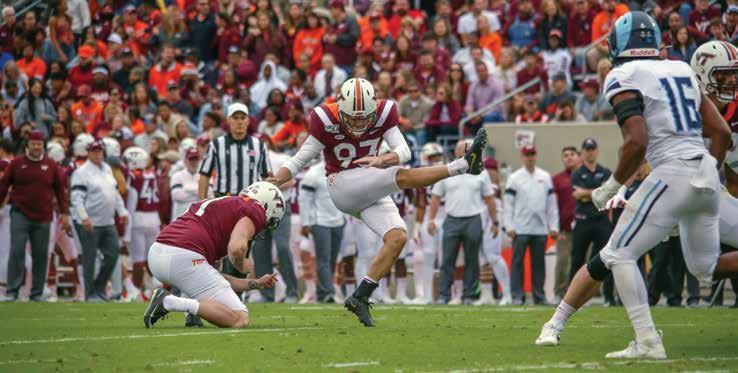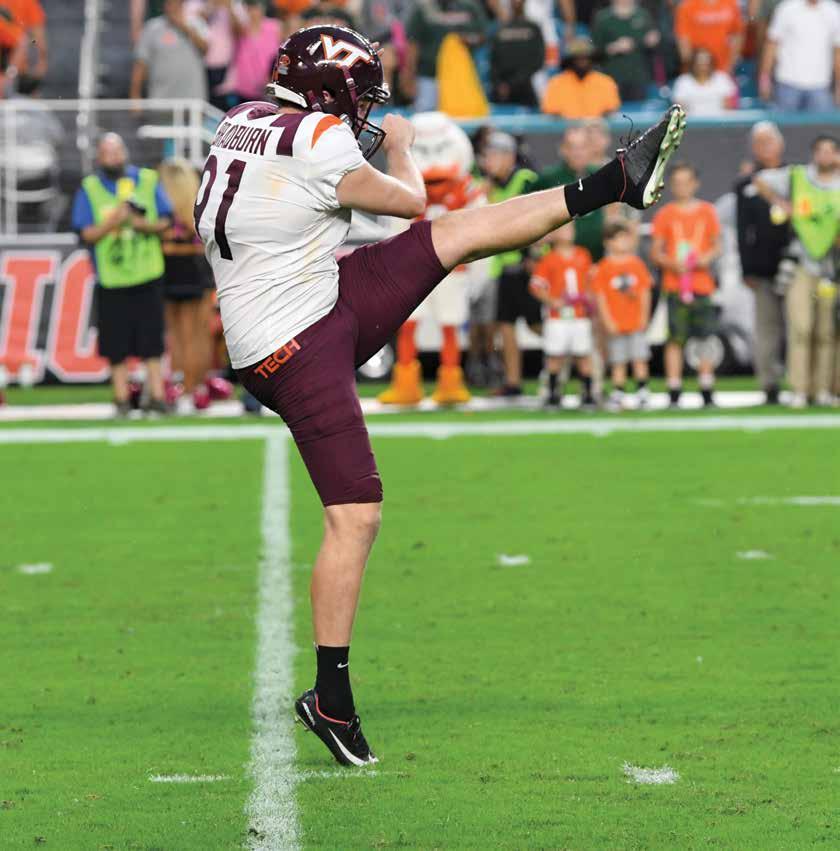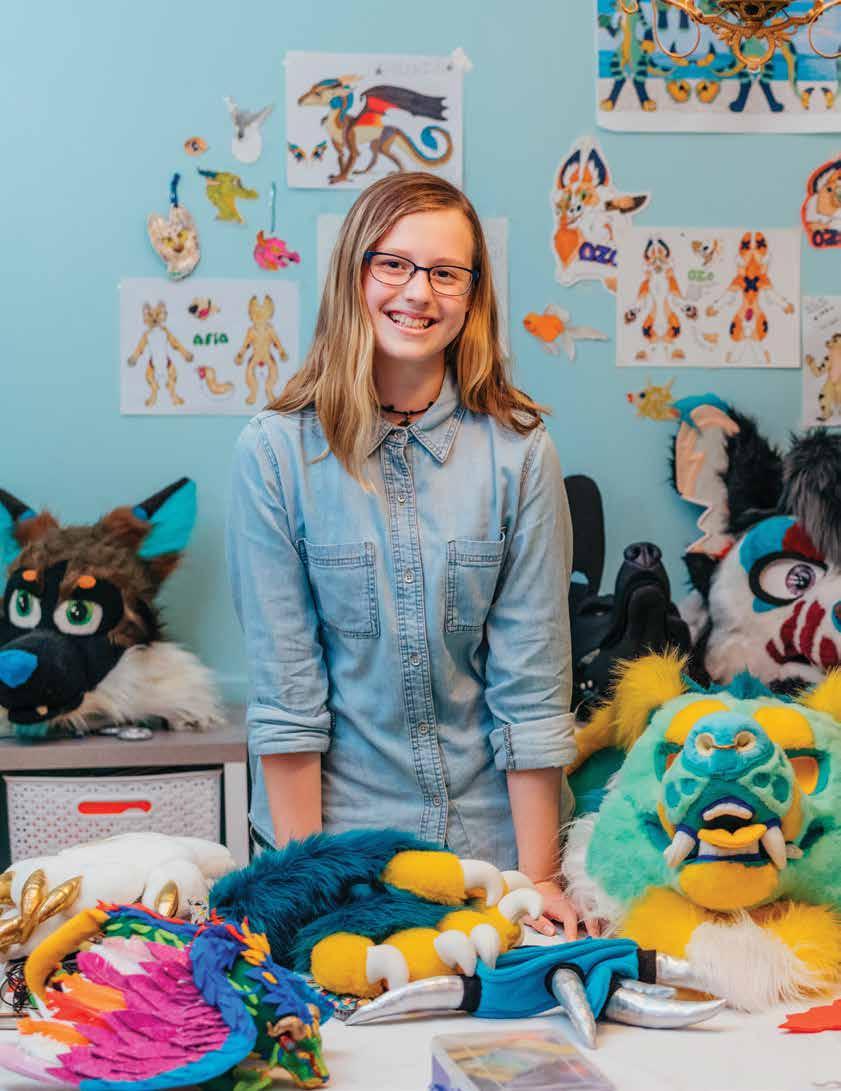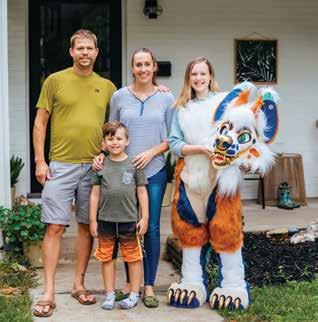
9 minute read
Virginia Tech Kickers
It’s a Real Kick! football kicks and kickers
Text by Joanne M. Anderson Photos courtesy of Virginia Tech Athletics Dept.
Advertisement
As a football game unfolds, the fans watch the snap, the run, the pass, the handoff, the play execution as team members in different positions move every which way. Someone simply cannot watch every player every second. But when the place kicker or punter steps onto the field, all eyes are trained on him. He might stand out on foul weather days for having the cleanest uniform on the gridiron. Pressure? Oh yeah. Important? You bet. Place kickers in the National Football League are billed as the most important players for being the highest scoring ones. They get the most opportunities to score and those extra points and 3-point field goals add up. Adam Vinatieri, 47, holds the record with having scored 2,673 points. His longest field goal is 57 yards, and his field goal success average is 83.8%. Something to aspire to. And aspire they do. The Virginia Tech team’s kickers this year are:
• Brian Johnson, #93, redshirt senior from Washington, D.C.; finished last season with an 82.6% field goal success rate, not missing any one of them inside of 40 yards.
• Oscar Bradburn, #91, senior from Sydney, Australia; set a VT singleseason record with 46.5-yard gross punting average last year; longest punt in 2019 69 yards.
• John Parker Romo, #96, senior from Peachtree City, GA; made 69 kickoffs last season plus a longest punt of 58 yards. Phi Theta Kappa Honors Society. • Mark Applegate, #92, redshirt freshman from Fairfax, VA; multiple allstate and all-region kicker accolades plus all-region and all-district punter. Soccer player.
Kicking has not always enjoyed its own keen, well-trained, seriously-focused personalities. Even in the late 1960s, a running back or back-up quarterback or offensive tackle would get out and kick the ball when necessary. He was referred to as the team’s “toe” when called upon. Before the game, someone might ask: “Who is your ‘toe’ today?” Then the true kicking position evolved along with an appreciation for the points a kicker can add to the score and all the difference it can make in standings, bowl games and championships.

Almost all of the college kickers come up through high school football, and many played soccer in middle school. The late Peter Rajecki came to the U.S. from war-ravaged Germany at age 16. He never knew his parents and did not read or write English. But he dreamed of being a place kicker when he learned about American football, transforming his informal soccer experience as a kid into playing for the University of Georgia and going pro with the NFL. Kicking camps and specialized coaching are available around the country now. The place kicker kicks the field goals and kickoffs and tends to kick soccer-style, from a few steps to the left and behind the ball, as opposed to straight toe kicking. In both cases, the ball is held or set in place, and his job is to kick it from wherever the offense has stalled on the field, and where the coach has enough confidence in his ‘toe’ to give it an attempt. The ball must go over the players and cross bar between the goal posts, into the end zone or as close to the 1-yard line as possible. Most place kickers wear special shoes like soccer boots, and very occasionally, one kicks barefoot. Kicking barefoot in high school is banned everywhere except Texas, and no longer does anyone kick barefoot in the NFL. The punter can be a different kicker - or not - whose sole objective is to send the pigskin as far and as high as he can. A good punter can evaluate distance and force so he sets up an advantageous field position for his team. Place kickers and punters are not often in the fray of running, tackling and getting tackled. Too valuable a team

commodity, a coach will tacitly place his kicker as a ‘safety’ on a punt return, lessening the chance of contact and injury. The most common injury for kickers include thigh strains and lower extremity muscle-tendon injuries, usually the hip adductor or hamstring, caused by kicking. The two penalties involving kickers are roughing the kicker or running into the kicker. The first one carries a 15-yard penalty and automatic first down for the kicking team. The second one is a 5-yard penalty, and it is still 4th down, unless they were 5 yards or less from the scrimmage line, in which case, they will enjoy another first down. All the kickers on the Hokie team have numbers in the 90s. Kickers and punters are frequently numbered in the 40s or 90s, which are the least in-demand numbers on a college roster. No team is allowed the number zero. Only two players have been permitted to wear the number 100 in National Collegiate Athletic Association history. Both were place kickers. West Virginia’s Chuck Kinder wore 100 in 1963 in honor of the Mountain State’s 100-year anniversary. Bill Bell sported the number 100 at the University of Kansas in 1969 to commemorate 100 years of football. So, when one of these VT kickers steps out on the field, knowing there are hundreds of thousands of eyes watching only him in person and via television, be gentle with any criticism and lavish with the praise. That spotlight moment, the hero or goat in the blink of an eye, carries immense pressure. It’s a real kick, literally and figuratively.
You deserve our best.


At Skyline National Bank, we’re built to bring out our community’s best. And while national may be in our name, community is in our hearts. Whether you’re buying a house, building a business, getting ready to retire or just opening a child’s first account, we’re going to answer every question, find the best solutions and help you get wherever you want to go. No matter where you’re headed, you will always get our best.

SkylineNationalBank.com

Member FDIC


Teeth, Tongues and Tails! Oh, My!

Text by Joanne M. Anderson Photos by Kristie Lea Photography

The once formal dining room in the Pruden family home in Blacksburg has been completely transformed, except for the chandelier and antique wood table, into Howling Dragon Studios. The only thing showing on the antique table is thick, elaborate, oak wood legs. The table top is completely covered for working space with scissors and sewing supplies and a sewing machine. A peg board holding thread spools hangs on one wall with an adjacent wall holding several drawings taped on it. These are Elly Pruden’s reference sheets, and this is her creative studio space. “Elly always loved stuffed animals and pretended, even as a toddler, to be different creatures,” states her mom, Tiffany [Boone] Pruden. “We made elaborate Halloween costumes which she helped design, like a monarch butterfly, hermit crab, blue jay and a wild thing from ‘Where the Wild Things Are.’” Elly was working with clay and hand sewing at a young age, and her mom taught her how to operate the sewing machine before she was 10. Elly, now 13 and a rising 8th grader, is a bonafide artist, costume designer and entrepreneur. She has 7,000 followers on Instagram [since March]. Her costume heads retail for $800 to $1,000, and she sells parts like teeth, tongues and tails, which can be switched out on the heads and fur suits. “People can change the look of any face


by switching to a different color, shape and length of tongue,” Elly explains. “Tails are the fun part of fur suits, and changing texture, color and length can alter the look.” Tiffany, a Blacksburg native, and her husband, Daniel, from Smithfield, Va., met at Virginia Commonwealth University where both were majoring in art. “We knew by the time Elly was 6 that she was incredibly imaginative, creative and talented,” Daniel relates. Her younger brother Wylder is now 6, so it’s only a matter of time to see what artistic talent emerges from the family gene pool. No pressure, Wylder! “It started with wanting to make her own stuffed animals,” Tiffany explains.

“Then she made animal ears to put on headbands, then came masks, tails and wings. Heads and full fur suits kind of naturally followed. She is inspired by dogs, wolves, reptiles and dragons.” All the design process, of course, starts in Elly’s head. She draws both by hand and on the computer, generating the design from every angle to view the finished product before she begins. She then takes a foam base for a head and sculpts and chisels it to the desired shape. There’s a lot of taping for a fur suit pattern, sometimes over her own body, which is peeled off, laid flat on newspaper and cut out. From here, Elly chooses fabric from the cubbies along one wall or the large pile of faux fur in a corner.
She cuts out the pieces and sews them together, incorporating different fabrics into a fur suit. She makes eyes from mesh, LEDs and other materials. Since the faux fur is long, Elly often shaves it in different places to add depth to a fur suit or interest to a tail or head or ears. There is a dress form in another corner for seeing the fit on a body. Her colorful paws and feet have pads and toenails. Stiff material is sewn on the bottom of feet, making them suitable for walking. “My mom taught me a lot about sewing, and I have watched youtube videos,” Elly says. “And there’s always trial and error along the way.” About a year ago, Elly opened

her Etsy shop where she sells things and has taken some custom orders. “She is making great progress saving for college, likely art school,” her dad says proudly. She shops often at JOANN (fabric store) and patronizes a few online shops like Big Z Fabric in California. Tiffany’s grandparents, James and Martha Boone, built this house in 1966. Everyone is convinced they would be very proud of their greatgranddaughter, Elly, and wouldn’t care a hoot about the dining room renovation.










